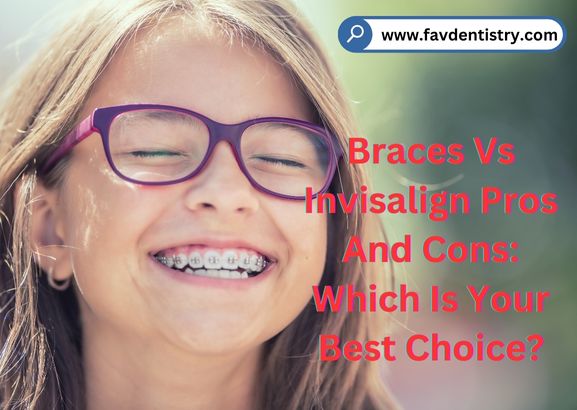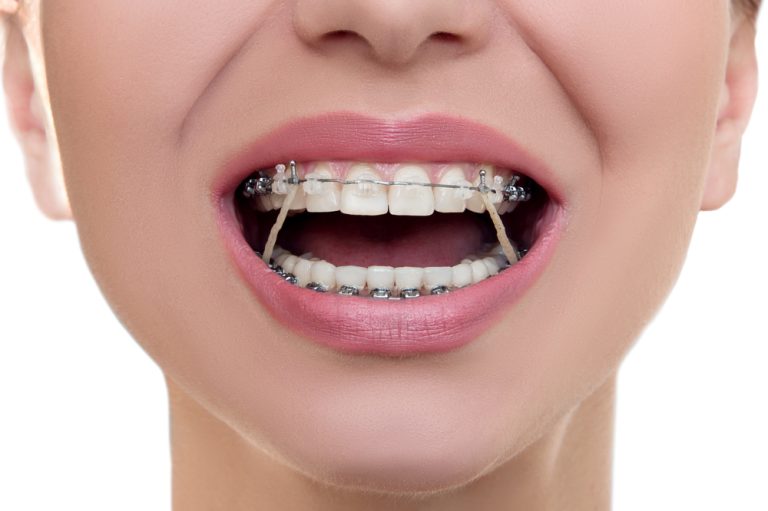Last Updated on 3 weeks by Dr. Michelle G. Brito
Invisalign is generally faster than traditional braces in straightening teeth. Invisalign treatment uses clear aligners that are custom-made and easily removable, allowing for quicker adjustments compared to braces.
Having straight teeth can enhance your smile and boost your confidence. Invisalign and braces are two popular orthodontic treatments that can help achieve this goal. While they both aim to align teeth and improve oral health, you may wonder which treatment is faster.
Invisalign treatment is generally faster than traditional braces. Invisalign uses a series of clear aligners that are custom-made for your teeth. These aligners are easily removable and are changed every few weeks to gradually shift your teeth into the desired position. On the other hand, braces involve brackets and wires that are adjusted periodically by an orthodontist. While the total treatment time may vary depending on individual cases, Invisalign typically requires less time than braces to achieve the desired results.
Benefits Of Invisalign Over Braces
Invisalign is a faster alternative to braces and has several benefits. Clear aligners provide a discreet look, making them almost invisible. Removable aligners allow for convenience in eating and cleaning. The flexibility of Invisalign enables a faster teeth straightening process. Unlike braces, there are no restrictions on what you can eat or drink.
In addition, Invisalign aligners are more comfortable than traditional braces. With Invisalign, you don’t have to worry about brackets or wires causing irritation or discomfort. The aligners are custom-made for a precise fit, ensuring effective treatment. Overall, choosing Invisalign over braces can provide a faster, more comfortable, and more convenient path to achieving a straighter smile.
How Invisalign Works
Invisalign and braces are both effective orthodontic treatments, but you may be wondering which one is faster. Let’s take a closer look at how Invisalign works. The clear aligners work by gently shifting your teeth into the desired position. It’s a step-by-step process where you wear a series of aligners that are changed every few weeks.
These aligners are customized to fit your teeth and are made of an explicit, discreet material. Throughout the treatment, dental check-ups are crucial to monitor progress and make any necessary adjustments. Invisalign offers a more comfortable and less visible option compared to traditional braces.
So, if you’re looking for a faster, more discreet way to straighten your teeth, Invisalign may be the right choice for you.
Effectiveness Of Braces
Braces have been used for decades to correct misaligned teeth and bite issues. They are effective in gradually shifting teeth into their proper position. Both traditional metal braces and newer ceramic braces can achieve excellent results. The process involves attaching brackets to the teeth and using archwires to apply pressure.
Over time, this pressure moves the teeth into alignment. The duration of treatment varies depending on the complexity of the case but typically ranges from 18 months to 3 years. Regular adjustments are made to the braces to ensure progress.
Traditional braces are still the most commonly used option due to their effectiveness. Patients’ commitment to wearing braces consistently and following their orthodontist’s instructions is crucial for achieving the desired results in the shortest possible time. Overall, braces can successfully correct various dental issues and enhance the appearance and function of the teeth.
Comparing Cost And Maintenance
When comparing the cost and maintenance of Invisalign and braces, it’s essential to consider insurance coverage for both options. Insurance coverage may vary depending on the dental plan. In terms of cost, braces tend to be more affordable than Invisalign.
However, Invisalign offers a more discreet treatment option. Maintenance and hygiene tips play an essential role in both methods. With braces, it’s crucial to clean around the brackets and wires diligently. On the other hand, Invisalign trays should be removed when eating and drinking, and they should be cleaned regularly.
Ultimately, the choice between Invisalign and braces depends on individual needs, preferences, and budget considerations. It’s best to consult with a dental professional to determine the most suitable option for achieving a beautiful and straight smile.
Invisalign Vs. Braces: Side Effects And Discomfort
Invisalign and braces are both teeth straightening options, but which one is faster in achieving results? One of the factors to consider is the potential discomfort during the treatment process. Invisalign, for instance, may cause some discomfort as the aligners apply pressure to shift the teeth gradually.
On the other hand, braces can lead to discomfort due to the brackets and wires. However, there are ways to manage and alleviate the pain. For Invisalign, changing to a new set of aligners at night can help reduce discomfort.
With braces, rinsing the mouth with warm salt water can provide relief. Additionally, avoiding hard and sticky foods and using orthodontic wax can also ease discomfort. While both options may cause some discomfort, the key is to follow the guidance of your orthodontist and communicate any concerns for a more comfortable teeth-straightening journey.
Invisalign Vs. Braces: Treatment Duration
Invisalign and braces differ in treatment duration. The time frame for Invisalign treatment varies depending on various factors. Factors affecting the duration of braces treatment include the complexity of the case and patient cooperation. Understanding the average treatment time for each option can help individuals make an informed decision.
Choosing The Right Option For You
Considering which treatment option to choose between Invisalign and braces depends on several factors. Personal preferences, as well as lifestyle choices, play a crucial role in this decision. Consulting with an orthodontist is essential to receive personalized recommendations based on your specific needs.
The expert advice will guide you in selecting the most suitable option that aligns with your goals.
Success Stories: Invisalign Vs Braces
Success stories of individuals who chose Invisalign or braces reveal their real-life experiences and outcomes. Patient testimonials shed light on their decision-making process and their satisfaction with the selected option. The analysis of each method’s overall effectiveness and results helps prospective patients make informed choices.
These personal accounts provide valuable insights for those considering orthodontic treatments. From hearing about the benefits and challenges of Invisalign to understanding the outcomes of traditional braces, these testimonials offer a glimpse into the journeys of individuals seeking orthodontic correction.
By documenting their progress and sharing their appreciation for these treatments, these testimonials contribute to a better understanding of the efficacy and satisfaction levels of both Invisalign and traditional braces.
Final Thoughts
Invisalign and braces are both effective teeth straightening options. Invisalign, a transparent aligner system, offers a discreet and comfortable way to align your teeth. On the other hand, braces use brackets and wires to straighten your teeth. When comparing the two, the speed of treatment is a significant factor to consider.
In general, braces tend to be faster than Invisalign when it comes to achieving desired results. However, the actual time needed for treatment may vary depending on the individual case. It’s crucial to weigh the pros and cons of each option and consult with a dental professional to make an informed decision.
By considering factors such as treatment duration, appearance, maintenance requirements, and cost, you can choose the fastest and most suitable teeth straightening solution for your needs.
Frequently Asked Questions Of Invisalign Vs. Braces Which Is Faster
Is Invisalign Faster Than Braces?
Invisalign is generally faster than traditional braces because it uses a series of clear aligners to gradually shift teeth. While treatment time varies, Invisalign can take 12-18 months, while braces can take 18-24 months.
Do Braces Work Faster Than Invisalign?
Braces can work faster in some instances, as they allow for more precise adjustments. However, advancements in Invisalign technology have significantly reduced treatment time, making it a comparable option for many patients.
Can Invisalign Give Faster Results?
Yes, Invisalign can provide faster results due to its innovative design. Using custom-made, clear aligners that are changed every few weeks, Invisalign gradually shifts teeth into place, often resulting in a shorter treatment time compared to traditional braces.
How Long Does It Take To See Results With Braces?
Results with braces vary depending on individual cases, but noticeable changes can typically be seen within the first few months of treatment. It can take about 6-12 months to see significant improvements, with full results typically achieved within 18-24 months.
Are Braces Or Invisalign More Effective?
Both braces and Invisalign are effective methods for straightening teeth. The choice between the two depends on individual needs and preferences. While braces may be better for complex cases, Invisalign is a popular choice for its discreet appearance and shorter treatment time.
Does Invisalign Work Faster For Adults?
Invisalign can work just as effectively for adults as it does for teenagers. In some cases, adults may experience faster results with Invisalign due to improved compliance with wearing the aligners, making it an attractive option for adults seeking orthodontic treatment.
Conclusion
Both Invisalign and braces are effective treatment options for straightening teeth. While Invisalign offers a more discreet and comfortable experience, braces may be faster in achieving desired results. The treatment duration for Invisalign depends on the complexity of the case and patient compliance, but it generally ranges from 6 to 18 months.
On the other hand, braces typically take around 18 to 24 months to complete. It is important to note that every individual’s orthodontic needs are unique, and the speed of treatment can vary. Ultimately, the decision between Invisalign and braces should be based on the recommendations of your orthodontist, taking into consideration factors such as dental health, lifestyle, and personal preferences.
Consulting with a qualified orthodontist will help determine which option is best suited for you to achieve the straight, beautiful smile you desire.



